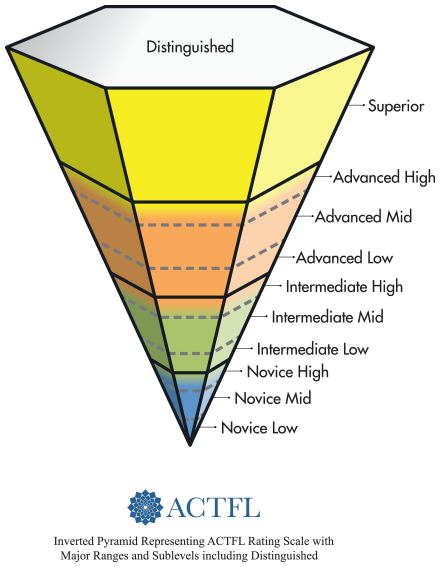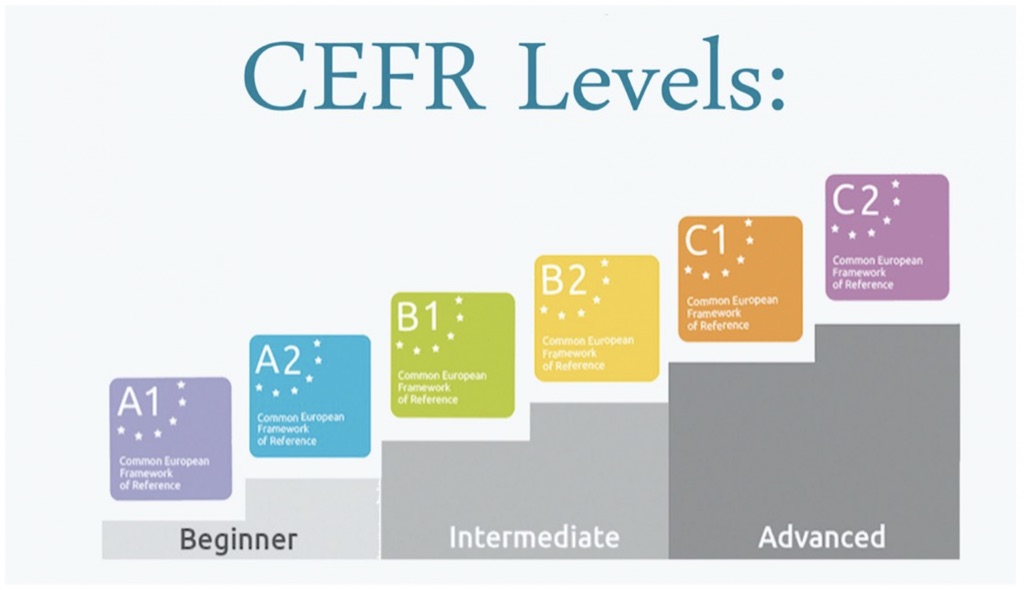Levels of Language Proficiency: How to Test Your Skills in 2023
All language learners want to know how much progress (if any) they’ve made. Levels of language proficiency describe an individual ability to use language in real-world situations, both in the spoken and written form. Having a way to gauge your progress and ability in a standardized way gives you a benchmark that can be referred to both for your own purposes or to inform others of your proficiency.
The most widely used descriptors for language proficiency level include the Common European Framework of Reference for Languages (CEFR), the American Council on the Teaching of Foreign Languages (ACTFL) standards, and the Interagency Language Roundtable (ILR) scale. Any one of these scales can be used to let you know where you stand in your progress towards fluency.
What Is Language Proficiency?
When was the last time someone asked you how well you speak the language you’re learning? What answer did you give them? We’re willing to bet that it wasn’t a short one because describing the knowledge of a language is not an easy task even for experienced teachers.
The main thing that makes it so challenging is the fact that our ability to comprehend, produce, and use language in daily life depends on four different skills: listening, speaking, reading, and writing. Can you say that you “know” Chinese if you can speak it fluently but can’t read any Chinese characters? What about speakers of nearly extinct languages that are preserved mostly in religious and official writings?
To provide satisfactory answers to these and other similar questions, experts established official language proficiency levels that describe achievements of learners on a scale from novice to advanced, taking into account listening, speaking, writing, and reading skills.
Language proficiency levels pave the way for standardized language testing and objective comparison of learners. Instead of relying on your subjective assessment of your skills, you can take a standardized foreign language proficiency test and know exactly where you are in your learning. Knowledge of your skill level allows you to focus your learning by being able to fix your weaknesses while refining your strengths.
What Are the Levels of Language Proficiency?
In the United States, the most commonly used language proficiency scales are the American Council on the Teaching of Foreign Languages (ACTFL) and the Interagency Language Roundtable (ILR). Canada uses its own proficiency scale, called Canadian Language Benchmarks (CLB) to determine fluency levels when assessing ESL learners. In Europe, the Common European Framework of Reference for Languages (CEFR) is used to provide a basis for recognizing language qualifications by educational institutions and businesses alike.
American Council on the Teaching of Foreign Languages (ACTFL)
The ACTFL scale describes what individuals can do with language in terms of speaking, writing, listening, and reading in real-world situations in a spontaneous and non-rehearsed context. It breaks down each skill into five main levels:

- Distinguished: Speakers at the Distinguished level are able to express themselves accurately, skillfully, and efficiently in a wide variety of contexts. They can use language to educate and persuade others or advocate a point of view that is not necessarily their own. Such speakers may still have a non-native accent or occasionally make an error.
- Superior: Speakers at the Superior level can communicate in a fluent manner on a broad range of topics, ranging from concrete to abstract. They form structured arguments without unnaturally lengthy hesitation to make their point. Such speakers make low-frequency errors when using more advanced grammar structures, but the errors are not distracting to native speakers.
- Advanced: Sitting right in the middle of the five language fluency levels that together make up the ACTFL scale, the Advanced level describes speakers who can effortlessly engage in conversations on concrete topics and use all major time frames. Advanced speakers have extensive vocabulary knowledge, but its limits quickly start to show when faced with highly technical topics.
- Intermediate: Speakers at the Intermediate level easily handle familiar topics and are able to recombine learned material to express themselves. They communicate at the sentence level and struggle with forming longer, uninterrupted statements. Their grammar, pronunciation, and vocabulary tend to be greatly influenced by their first language, which may confuse some native speakers.
- Novice: As the least advanced of all ACTFL levels, Novice speakers can only use isolated words and phrases. They often struggle to find the right word, and native speakers must greatly simplify their language to help Novice speakers understand what they’re saying.
Along with this scale, ACTFL also offers the ACTFL Performance Descriptors for Language Learners as a way to gauge performance in a language. This consists of their 5 C’s of world readiness: Communication, Cultures, Connections, Comparisons, and Community. Within these 5 C’s is the understanding that just knowing the language in a mechanical sense is not enough for full proficiency, and that understanding of culture is also vital.
Interagency Language Roundtable (ILR)
The ILR scale describes language proficiency on a scale of 0–5. This standard for expressing one’s ability to communicate in a language is used in the United States’s Federal-level service. Here’s a brief description of its levels:
- No proficiency: Level 0 speakers can sometimes understand and produce isolated words, but they don’t have any ability to participate in a conversation.
- Elementary proficiency: Level 1 speakers understand the language enough to fulfill their traveling needs, such as asking for direction, buying groceries, or checking into a hotel.
- Limited working proficiency: Level 2 speakers can handle most social situations and ask for help at work. They use elementary grammar constructions and don’t understand more advanced vocabulary.
- Professional working proficiency: Level 3 speakers have acquired professional working proficiency, which means they can use the language for work-related purposes despite having a strong accent and making minor grammar errors.
- Full professional proficiency: Level 4 speakers have extensive vocabulary that enables them to effortlessly communicate with highly skilled professionals.
- Native or bilingual proficiency: Level 5 speakers express themselves just as fluently as educated native speakers.
United States government agencies as well as educational institutions that have government focused educational programs such as Georgetown University use this scale to measure proficiency for students, employees, and job candidates.
Canadian Language Benchmarks (CLB)
Canadian Language Benchmarks serves the same purpose as ACTFL and ILR, but it relies on a 12-point scale of task-based language proficiency descriptors, covering all four skills that determine one’s linguistic competency: speaking, reading, listening, and writing.
The history of the CLB goes back to 1992. What sparked its creation was a federal government initiative to support immigrants and their linguistic needs. The first fully realized version of the CLB was published in 2000. Since then, parts of the CLB were revised several times to better reflect our current understanding of the process of second language acquisition.
The 12-point scale of proficiency descriptors around which the CLB revolves can be divided into three stages:
- Basic Proficiency: This stage roughly corresponds to the no proficiency and elementary proficiency stages of the ILR scale.
- Intermediate Proficiency: This stage roughly corresponds to the limited working proficiency and professional working proficiency stages of the ILR scale.
- Advanced Proficiency: This stage roughly corresponds to the full professional proficiency and native or bilingual proficiency stages of the ILR scale.
While the CLB is readily used to plan g curricula for language instruction in Canada, it’s not intended as a curriculum by itself, in part because it’s not tied to any specific instructional method. A comprehensive overview of the CLB and its levels of language proficiency is published on the website of the Centre for Canadian Language Benchmarks. The overview is available in both English and French.
Common European Framework of Reference for Languages (CEFR)
Created by the Council of Europe to provide a method of learning, teaching, and assessing which applies to all languages in Europe, CEFR describes achievements of learners of foreign languages on a six-point scale using “can-do” descriptors.

- C2 (Mastery or proficiency): C2 is the highest of all CEFR levels. Those who achieve it can understand everything they hear or read and are able to express themselves with the same degree of spontaneity as native speakers.
- C1 (Effective operational proficiency or advanced): C1 speakers understand and use advanced grammar and vocabulary. They can actively participate in many social situations, producing well-structured utterances.
- B2 (Vantage or upper intermediate): B2 speakers can interact with native speakers without either party feeling any strain. While they may not be able to understand all the nuances of complex texts, they can grasp the main ideas and express them using their own words.
- B1 (Threshold or intermediate): B1 speakers can deal with familiar situations and connect simple sentences. They can talk about themselves without any help, but describing unfamiliar subjects is difficult for them.
- A2 (Waystage or elementary): A2 speakers can describe familiar routines and areas close to them in simple terms. They can use common expressions when shopping, traveling, and socializing, but spontaneous communication is a struggle for them.
- A1 (Breakthrough or beginner): A1 speakers can introduce themselves and interact with others in a simple way, using isolated words and basic phrases.
How to Determine Language Proficiency?
Now that you’re familiar with language levels of proficiency, you might be wondering which level best describes your skills. To find out, you can either conduct a self-assessment, or you can sign up for an official language proficiency test. After taking a test or assessment, you can then establish the areas where you need work and what your strengths are currently. This can help you guide your further learning along with how you plan on using your language skills.
ACTFL administers over 700,000 tests per year in 60 different countries, and CEFR exams are available both across Europe and online. Because standardized tests tend to focus on specific grammar and vocabulary, it’s possible to prepare for them by creating a custom lesson plan using Encore!!! language learning app. The ability to craft that custom lesson plan will help you reach new heights in your proficiency and raise your scores in all of these tests.

A great test score can open up many excellent job and study opportunities, so it’s a good idea to spend some time practicing. Decide which assessment works best for your needs and location, then practice and start your journey towards better understanding of your language of choice.
Conclusion
Understanding commonly used levels of language proficiency allows you to know just how far you need to go in your learning to achieve your dream of fluency. It helps you pick learning material that corresponds to your foreign language proficiency level and provides the optimum learning value.
When preparing for your test, or once you know your skill level and what you need to improve on, you can use Encore!!! app to keep improving on your journey to fluency.
FAQs about the Levels of Language Proficiency
1. What does language proficiency mean?
Language proficiency is a measure of your ability to listen, speak, read, and write a language. The combination of your abilities in these fields is your proficiency in the language.
2. How do you measure language proficiency?
There are several standardized language proficiency tests that are based on different standards, yet all have the same goal of providing a measure of skills. The American Council on the Teaching of Foriegn Languages, Interagency Language Roundtable, Canadian Language Benchmarks, and the Common European Framework for References Of Languages are the main organizations that offer these proficiency tests.
3. When can you say you are fluent in a language?
Fluency in a language is generally determined to be achieved when you can communicate in the language effortlessly. The ability to switch automatically into the language and not have to process the translation between languages is the key indicator to fluency.
4. What is elementary proficiency in a language?
Elementary proficiency in a language is level 1 on the Interagency Language Roundtable scale. This level is one of the most basic and means that you can communicate for travel purposes, such as asking directions, checking into a hotel, or buying groceries.
5. How can I improve my language proficiency?
If you are looking to improve your language proficiency, then a custom lesson plan that lets you focus on improving your weaknesses is for you. Encore!!! app offers just that, with the ability to craft a custom plan or use an existing plan curated by our users.

